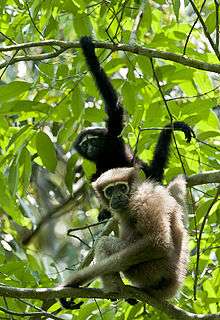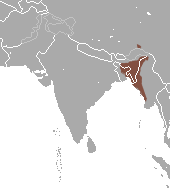Western hoolock gibbon
| Western hoolock gibbon | |
|---|---|
 | |
| A female in the foreground, and a male in the background | |
| Scientific classification | |
| Kingdom: | Animalia |
| Phylum: | Chordata |
| Class: | Mammalia |
| Order: | Primates |
| Family: | Hylobatidae |
| Genus: | Hoolock |
| Species: | H. hoolock |
| Binomial name | |
| Hoolock hoolock (Harlan, 1834)[2] | |
 | |
| Western hoolock gibbon range | |
The western hoolock gibbon (Hoolock hoolock) is a primate from the gibbon family, Hylobatidae. The species is found in Assam, Mizoram, Bangladesh and in Myanmar west of the Chindwin River.[3]
Classification
Mootnick and Groves[4] stated that hoolock gibbons do not belong in the genus Bunopithecus, and placed them in a new genus, Hoolock. This genus was argued to contain two distinct species which were previously thought to be subspecies: Hoolock hoolock and Hoolock leuconedys which were later have found that the 2 species have a bigger difference to that of white handed gibbons than bonobos to chimpanzees.[5]
Vocalisation
Like other gibbons, hoolock gibbon pairs produce a loud, elaborate song, usually sung as a duet from the forest canopy, in which younger individuals of the family group may join in. The song includes an introductory sequence, an organising sequence, and a great call sequence, with the male also contributing to the latter (unlike in some other gibbon species).[6]
Habitat
In India and Bangladesh it is found where there is contiguous canopy, broad-leaved, wet evergreen and semi-evergreen forests dipterocarpus forest often mountainous. The species is an important seed disperser; its diet includes mostly ripe fruits, with some flowers, leaves and shoots.
Conservation
There are numerous threats to western hoolock gibbons in the wild, and are now entirely dependent on human action for their survival. Threats include habitat encroachment by humans, forest clearance for tea cultivation, the practice of jhuming (slash-and-burn cultivation), hunting for food and “medicine”, capture for trade, and forest degradation.[1]
Over the last 30–40 years, western hoolock gibbon numbers are estimated to have dropped from more than 100,000 (Assam alone was estimated to have around 80,000 in the early 1970s) to less than 5,000 individuals (a decline of more than 90%).[7] In 2009 it was considered to be one of the 25 most endangered primates,[8] though it has been dropped from the later editions of the list. [9]
Diet
Hoolock gibbons feed mostly on various fruits, with some leaves, flowers and insects.
See also
References
- 1 2 Brockelman, W.; Molur, S. & Geissmann, T. (2008). "Hoolock hoolock". IUCN Red List of Threatened Species. Version 2008. International Union for Conservation of Nature. Retrieved 4 January 2009.
- ↑ Harlan, Richard (1834). "Description of a Species of Orang, from the North-Eastern Province of British East India, Lately the Kingdom of Assam". Transactions of the American Philosophical Society. 4: 52–59. JSTOR 1004829
 .
. - ↑ Groves, C. P. (1967). "Geographic variation in the hoolock or white-browed gibbon (Hylobates hoolock harlan 1834).". Folia Primatologica. 7: 276–283. PMID 5626313. doi:10.1159/000155125.
- ↑ Mootnick, A. R. & C. P. Groves (2005). "A new generic name for the hoolock gibbon (Hylobatidae)". Int. J. Primatol. 26: 971–976. doi:10.1007/s10764-005-5332-4.
- ↑ Mootnick, A. R. (2006). "Gibbon (Hylobatidae) species identification recommended for rescue or breeding centers". Primate Conserv. 21: 103–138. doi:10.1896/0898-6207.21.1.103.
- ↑ Kakati, Kashmira; Alfred, J. R. B.; Sati, J. P. (2013). "Hoolock gibbon". In Johnsingh, A. J. T.; Manjrekar, N. Mammals of South Asia. 1. Hyderabad: Universities Press. pp. 332–354. ISBN 978 81 7371 590 7.
- ↑ "Western Hoolock Gibbon, Hoolock hoolock". Retrieved 2008-03-10.
- ↑ Mittermeier, R.A.; Wallis, J.; Rylands, A.B.; Ganzhorn, J.U.; Oates, J.F.; Williamson, E.A.; Palacios, E.; Heymann, E.W.; Kierulff, M.C.M.; Long, Yongcheng; Supriatna, J.; Roos, C.; Walker, S.; Cortés-Ortiz, L.; Schwitzer, C., eds. (2009). "Primates in Peril: The World's 25 Most Endangered Primates 2008–2010" (PDF). Illustrated by S.D. Nash. Arlington, VA: IUCN/SSC Primate Specialist Group (PSG), International Primatological Society (IPS), and Conservation International (CI): 1–92. ISBN 978-1-934151-34-1.
- ↑ Mittermeier, R.A.; Schwitzer, C.; Rylands, A.B.; Taylor, L.A.; Chiozza, F.; Williamson, E.A.; Wallis, J., eds. (2012). "Primates in Peril: The World's 25 Most Endangered Primates 2012–2014" (PDF). Illustrated by S.D. Nash. IUCN/SSC Primate Specialist Group (PSG), International Primatological Society (IPS), Conservation International (CI), and Bristol Conservation and Science Foundation: 1–40.
